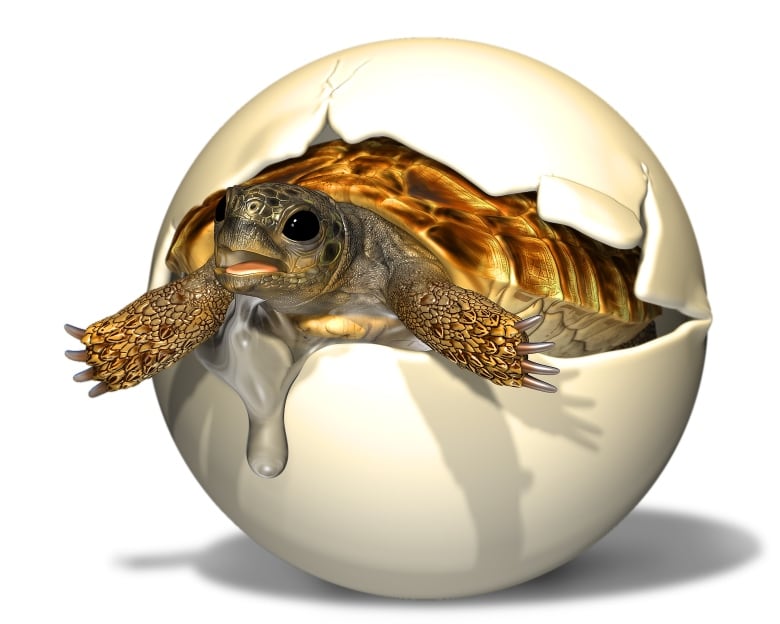A fossil egg found by a Chinese farmer has turned out to have a rare surprise inside: A baby turtle nearly ready to hatch. And that's allowed scientists to make a unique and important connection, a new study reports.
"This is actually the first time that [fossil] turtle eggs or a nest really could be attributed to a particular turtle," said Darla Zelenitsky, a co-author of the study and an associate professor of paleontology at the University of Calgary.
The egg belonged to a nanhsiungchelyid turtle, an ancient, huge, land-dwelling creature that lived in Asia and North America and was related to modern softshell turtles, according to the study published Wednesday in the journal Proceedings of the Royal Society B.
The turtle lived among dinosaurs — such as long-necked, plant-eating sauropods, duck-billed hadrosaurs and large meat eaters, similar to tyrannosaurs — during the Cretaceous period. It went extinct with them.
"It was a giant turtle for the time," said Zelenitsky.
She estimates the female that laid the egg was more than 1.6 metres long — roughly as long as an average woman is tall, and longer than a giant Galapagos tortoise, although it had a flatter, less domed shell.

Like the Galapagos tortoise, it lived entirely on land. Nanhsiungchelyids lived in arid desert environments, but the egg was found near the shores of an ancient river.
"During the rainy season, these river systems may have overflowed and buried the eggs that were on the floodplain, potentially preserving them as fossils," said Zelenitsky.
The Henan region of China where it was found is also known for fossil dinosaur eggs, she said.

The estimated size of the embryo's mother is based on the known relationship between the size of a turtle's body and its eggs. The fossil is roughly the size and shape of a tennis ball — perfectly spherical — with a shell as thick as that of a much bigger ostrich egg.
"I was thinking, 'How did this little turtle hatch out of this egg, with it being so thick?'" Zelenitsky recalled. "They must have been doing a lot of flexing and extending … to work their way out."
The embryo was extremely well preserved, allowing researchers to X-ray it with a CT scanner and reconstruct its skeleton in 3D. They concluded it was a nanhsiungchelyid after comparing it to other ancient and modern turtles.
Egg helps identify nests
By identifying that egg, which was found by itself, the researchers were also able to identify entire nests of identical turtle eggs found elsewhere. It showed that nanhsiungchelyids normally laid 15 to 30 eggs at a time.

The farmer who originally found the egg in 2018 donated it to a museum.
The lead author of the study, Yuzheng Ke, a graduate student at the China University of Geosciences in Wuhan, contacted Zelenitsky and asked her to participate because she previously had done research on dinosaur eggs and even a pregnant turtle.
Zelenitsky said she jumped at the chance: "I was excited about it the entire time."
The study was funded by the National Natural Science Foundation of China and the Natural Sciences and Engineering Research Council of Canada.
Daniel Lawver, a researcher at Stony Brook University's School of Medicine in New York who was not involved in the study, has been doing similar, not-yet-published research on a different turtle egg and embryo.
He was pleasantly surprised by the study, he said, as a turtle with an identifiable embryo inside is a "very, very rare" find and this one is a "really cool specimen."
That's because most turtles have thin eggshells composed of a mineral called aragonite that's unstable on the Earth's surface. During fossilization, it's converted to another mineral that makes them hard to identify, Lawver said. And often, they're fossilized before the embryo has developed, resulting in a fossil eggshell filled with rock.

Jordan Mallon, a paleontologist at the Canadian Museum of Nature in Ottawa who has studied nanhsiungchelyid fossils from North America, including Alberta, agrees with the identification of the embryo. He was also not involved with this research.
The thick, water-retaining eggshells add to evidence that the turtles were fully land-dwelling, he said, something that has been debated.
The techniques used in the study could later be used to examine older turtle embryos and uncover long-standing puzzles about turtle evolution, like how their shells evolved, said Mallon.
"I think the authors of this paper are sort of leading the way."
https://news.google.com/__i/rss/rd/articles/CBMiTGh0dHBzOi8vd3d3LmNiYy5jYS9uZXdzL3NjaWVuY2UvbmFuaHNpdW5nY2hlbHlpZC1mb3NzaWwtZWdnLWVtYnJ5by0xLjYxNDQwNTHSASBodHRwczovL3d3dy5jYmMuY2EvYW1wLzEuNjE0NDA1MQ?oc=5
2021-08-18 12:09:28Z
52781811664545
Tidak ada komentar:
Posting Komentar